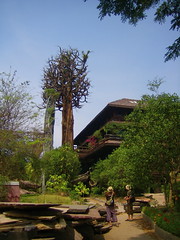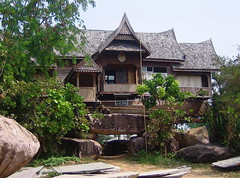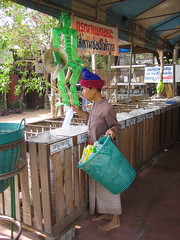Righteous Protests or Religious Fanatics?
Part four in a series of stories from my road trip in Thailand, participating in a study tour hosted by Pun Pun farms, to visit local examples of sustainable living in the Northeast and in Chiengmai.
When I mentioned the Santi Asoke Buddhist group to my Aunty Ah Padt, she expelled air through her closed lips making a sound, which I interpreted to mean "what a joke that group". I would have expected a similar reaction from a Republican upon the mention of Al Gore, but not from my Ah Padt, a practicing Buddhist. Still she was a Bangkok businesswoman and held the decidedly non-sustainable, pro-growth values of business people the world over. The Santi Asoke group had apparently gone too far.
Newsweek too, in a recent article on Buddhist political activism, characterized the Santi Asoke sect as an "ultraconservative" fundamentalist religious group that had organized political protests against the Thaksin administration. The emphasis was not on Thaksin, where it should have been, but on the potential for these religious protests to lead to violent uprisings. My fears of a perceived communist threat were outdated. I had forgotten that George W. had redefined the new threat to world peace as one that would come from religious fanatics usually identified as Muslim terrorists. Now Newsweek was comparing Buddhist protests to Muslim fundamentalists. This blatant bias irked me.
Back on our two-bench truck, our tour group of 16 Westerners in search of examples of sustainable lifestyles, drove for several hours towards the Laotian border to visit one of the largest branches of the Santi Asoke network, in the province of Ratchatani. At least the road was good. That much the government had managed to do, the better to rush raw materials and food to Bangkok.
We arrived in a large park like compound where we could see, looming over us, extraordinary wooden buildings and what looked like a very tall tree with strangely twisting branches at the top forming a sphere. We hopped out, excited to explore such interesting examples of Thai architecture and were greeted by a woman with bobbed hair wearing a blue denim coat faded to a stonewashed blue.
A Santi Asoke Intentional Community
"Would you like to eat first or see the grounds first?" she asked us. Food could wait. We were eager to know the stories behind these buildings. One had the characteristic upturned roofline of Thai design, but was grafted onto a boat. This, our guide told us, was to put to use the retired rice barges that had once plied the rivers to Bangkok, but had now given way to a faster trucking system. Ah, we mused, so this was not a whimsical vision of a new spiritual order, but simply an example of creative reuse. To add to the mystical vision of airborne arc, the hybrid building was propped up into the air so high you could walk under it. This we learned later was a land that was flooded three to four months of the year.
Flooding was probably why the original plot of land had been donated to the sect. Twenty monks came to live on it, supported by food brought to them by the local farmers. Six women joined them and soon more people came seeking to live by the principles of voluntary simplicity and the communal work ethic that the group espoused. The network had also implemented some of E. F. Schumacher's ideas. Asoke sympathizers had translated the chapter on Buddhist economics from his book Small is Beautiful:Economics As If People Mattered.
Jo, acting as our translator, pointed out that the first to come were educated middle class Thais, especially teachers whose salaries were not going to cut it after the currency collapse. They were followed by farmers in debt. The economic collapse would swell their numbers to 300 members. Schools were created for the children and workshops given to the adults in self-sufficiency and organic farming.
We were served a vegetarian lunch in a large hall and shown a documentary film of the group on their giant flat screen TV. Though they did all wear the blue farmer's outfit that so reminded me of communist workers' cooperatives, they were not the extremist fundamentalists Newsweek would make them out to be. They still only followed the five precepts and ate two meals a day together, not the eight precepts as Newsweek described. And since when did abstaining from sex and eating only one meal a day constitute religious fanaticism especially in a Buddhist sect, I ask you?
While I was there, I did manage to break one of their rules by catching an afternoon nap while everyone shopped and if they had made note that I was a woman wearing shorts (but not too short) that would have been two, but these rules felt more like guidelines than fanatic beliefs. Nobody looked at me with disapproval. And when I forgot my jacket, one of the members retrieved it for me, while another asked if it was made in Thailand. Yes it was, because I am rather fond of the clever simplicity of those farmer's jackets and was wearing one that day with another short sleeve one underneath.
As we toured the center we were shown the organic vegetable garden and the recycle center where hand lettered signs in Thai and English described over twenty categories of materials including plastic bags which were washed and dried for reuse. The community made enough money from selling recyclables to fund their educational cable TV channel.
We also discovered that the intriguing three story high trees were actually sculptures, made by a local artist, from cement. The bark texture was impressively real. I asked the reason for these tree sculptures. The oddly simple answer was that they gave visitors something to see. Yes, Thai people liked to go to parks and see something manmade and the group often invited the townspeople to come to the community for special occasions such as the King's birthday. Lots of food and community made products were given away in an effort to spread their philosophy of self-sufficiency and meritism.
Protests and Engaged Buddhism
The real crime that the Santi Asoke group founder had committed, as I read later in the Christian Science Monitor, was to claim that the lax practices of the Thai monastery system had fostered materialism and corruption within. Unable to come to a resolution on this matter, the Santi Asoke leader had then formed his own sect. The military government of the day, fearing for their own relationship with the religious order most likely, had not allowed the new sect to register under the monastery system, thus reporters could later say that they were a rogue group of fundamentalist fanatics. That the group of Santi Asoke protesters chose the name the Dharma Army was an unfortunate PR choice that implied that they actually had arms and were not, as the word "dharma" would imply to a Buddhist, a group devoted to peaceful protests.
What the good liberal American reader brings to the mix is a healthy distrust of religious groups getting involved with politics. But much like the Baptist church in the American south, the Thai temple serves as a community center and is often the only place where a village can assemble and organize themselves against injustice, with the help of the most educated leaders of the community—the monks.
"But how are they related to the military," I asked Jo. After all, Thaksin had been ousted by a military coup, but I had never discovered how that came about. It had been one of my goals to find out during my trip.
"They are not related", he told me and explained to me that the Santi Asoke group had not staged a political protest. They were protesting on moral grounds, that's why it could be justified under the principles of Buddhism, which included practicing social justice. This I could understand, having discussed, among American Buddhists at home, whether anti-war protests could be considered a practice of Engaged Buddhism.
The military had stepped in fearing general unrest, he told me.
And what was their agenda? I asked.
Corruption, of course. Suddenly I saw how it worked. The military controlled government did not want the country in turmoil because that would cut into their nicely set up system of kick backs that was entrenched in an orderly, but corrupt government system. Nor would they want Thaksin privatizing everything, as prescribed by the prevailing forces of globalization, because that would take away the whole shooting match. That the Newsweek reporters could so glibly exploit the details of the Santi Asoke protest struck me as so unfair. Could it be that their issues of social justice did not fit into the story the United States was telling itself about the threat of armed revolt from People Who Hate Our Freedoms which then forces us into military intervention and everlasting war?
Everywhere in the world, grassroots movements were solidifying a response to the impact of globalization, but this trend was going unreported. Sustainability in itself was not worthy of discussion. And of course sustainable business practices, as modeled by groups like the Santi Asoke sect, was a threat to the prevailing mantra of ever more growth and profit.
We drove back into town and stopped at a store, one of the many that had been opened by the Santi Asoke group. It was about the size of a 7 Eleven and was stocked with the products made by the industrious members of the community. We filed in and perused the shampoos, herbal remedies and the implements needed to use them. I loaded up on bars of soap with exotic ingredients—radish, tamarind, tomato, garlic, ginger and citrus, plus a bottle of passion fruit juice which I downed on the spot.
The Final Analysis
When I showed my 89-year-old Aunty Lily my pictures of the tour, it transformed her opinion of me. I became someone with values that she and my grandmother, too, would have shared.
"You have done much good by going on this tour," she said, implying that I had accumulated good merit. I hadn't expected such a response just for being a witness to acts benefiting society. Aunty Lily had been a businesswoman too, in her day, but she had a sense of justice that I had come to count on. She asked me to show the pictures to her Wednesday lunch companions, a doctor and a teacher. Both knew all about the Santi Asoke group. The teacher told me she had a friend—a dentist who offered his services to the group as part of his merit making. I was relieved that they considered the Santi Asoke people to be worthwhile. After Ah Padt's reaction I was beginning to wonder if what I had seen was recognized by the general Thai population for the good they were doing or if the Thais, too, considered them inherently suspect.
The final analysis may not yet be in. Reactions to the return of Thaksin were also mixed. I was still in Thailand at the time and saw his smiling mug on the cover of magazines as he was joyfully welcomed by his supporters. Newsweek had described him as a populist leader, but his economic policies known as "Thaksinomics", which included a 3-year moratorium on farmers' debts, were not meant to encourage sustainability since he had also ordered state banks to aggressively extend more loans to the same poor farmers and villagers. His mega projects for Thailand's infrastructure would run up a bill of $50 billion, while his "populist" policies for healthcare and education were under funded. Now he would face trial for his crimes of abuse of power, tax evasion, cases of fraud, loans to Burma that indirectly benefited his telecom business and illegal bidding on a state contract involving 90 million rubber saplings (for expansion of rubber plantations to the North and Northeast—home of above farmers).
"What about democracy?" I had asked Jo. "It didn't look good to the world when the military coup took away democracy", I added. I had taken this failure of my home country to hang onto democracy as a personal slight that made Thais look backward. A military coup was just so old school.
"There is no democracy," Jo answered testily, "there is only money." I couldn't argue with that.
Also posted at energy bulletin
Labels: globalization, Isaan, Santi Asoke, sustainability, Thailand, travel








7 Comments:
It seems to be the common practice among modern governments, especially since 9/11 gave them carte blanche to do so, to label any group that runs counter to their main objectives as a terrorist group. And as your aunt so eloquently said, "There is no deomocracy, there is only money." And at least in the case of powerful western governments like the United States, the government is now mostly controlled by large corporate interests, so any group that isn't furthering their interests isn't furthering the government's interest, and is therefore a terrorist group.
Ever notice how when discussion comes around to global warming or easing our foreign oil dependence, serious discussions about curbing our usage by riding bicycles, implementing decent rail systems, and simply just driving less, never really seem to take place? No, it's always about what new automotive techonology we can implement, and how many more oil wells can we drill domestically. The car and oil companies pump a lot of money into politicians' pockets.
Likewise, when our economy is in the crapper, as it is now, does our mighty leader urge us to be responsible with our money, to save and be prepared for the worst? No, he urges us to go shopping! Gotta keep those corporations earning money so they can keep pumping money into the campaigns. It's a sick little game...
Sorry to ramble so far off the main topic of your post, but so much of what you witnessed there seems very applicable to situations happening here.
On a completely different note, it sounds like you've had an amazing (and very educational!) trip. It's gotta be pretty cool to still have roots in a completely different culture like that, on the other side of the world. Having that different perspective has to give you a much deeper insight to what happens in our own country. I've really enjoyed reading your stuff. Keep up the good work.
-Ryan
Thanks Fonk. I agree with all your comments about how various governments further their interest. And even though I grew up on the other side of the world, I've always felt that we were as interconnected as brother and sister because of the influence of Western culture and consumption habits on my side of the world. (And I appreciate your work to help curtail that consumption over at your blog.) It just astonished me that now that some original thinking has evolved in Thailand it is being written into that Western myth of "you're either for us or agin us". I liked it better when we went completely unnoticed.
I will be writing more about Jo, an original thinker and founder of the earthen building movement in Thailand. It was he who gave me my closing line about democracy, rather than my aunt. Sorry I didn't make that more clear.
This was a wonderful and enlightening read, AK.
i. Those tree sculptures must've looked fantastic.
ii. "Dharma Army" is indeed a terrible, oxymoronic PR choice.
iii. "A military coup was just so old school." That's a funny way of putting it.
iv. Thank you and right on to Engaged Buddhism.
Amanda,
Ah, it's inspiring to read about global adventures, undertaken with beginner's mind. It is making me itch to return to Asia (and I've got some ideas percolating). The intentional communities sound fascinating. If you are looking for more, there are actually quite a number of them in England/ Scotland/ Australia. For instance, see http://www.newstatesman.com/blogs/life-at-findhorn (Findhorn).
It sounds like you may not be in Thailand anymore. In case you are, there is a new monastic/laypeople's center being built by a Thai nun who visited the Bay Area last year. Yes, a nun -- it will be one of the first centers in Thailand built by a woman, and intended to support women Buddhists. The goal is to use sustainable building materials and put together educational programs for good living for the local people.
No website, but the nun's name is Ven. Poonsirivara, and the center will be called Suan Sirishamma. I have her email if you're interested.
Thanks for sharing your journey!
Kim
Oops - Suan Siridhamma, that is.
Thanks Kim. Yes intentional communities have interested me for some time and I read about Findhorn when I first became a gardener. I would love to go there. We did visit an intentional community in the Chiengmai area that was started by a Thai nun called the International Women's Partnership for Peace and Justice. They had some impressive earthen buildings and a temple built entirely by women, including nuns from Burma; it was given a lot of Tibetan symbols in sympathy with the Tibetans. The community has a lot of programs and retreats. You can also just stop by and stay there in their guest house. I'm glad to see other such projects forming. I had not heard of Suan Siridhamma.
I have been recommending a book called "My Stroke of Insight - a Brain Scientist's Personal Journey" by Jill Bolte Taylor and also a TEDTalk Dr. Taylor gave on the TED dot com site. And you don't have to take my word for it - Dr. Taylor was named Time Magazine 100 Most Influential People, the New York Times wrote about her and her book is a NYTimes Bestseller), and Oprah did not 4 interviews with her.
Post a Comment
<< Home